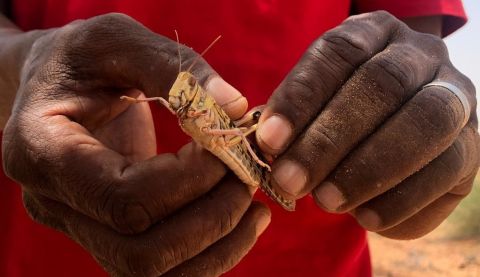What are desert locusts and how are they affecting East Africa?
13 February 2020
The destructive desert locust is causing widespread havoc and devastation in East Africa right now, by feeding on vital food crops and pastures, that families already struggling with coronavirus need to survive.
Find out what a desert locust is, why it’s potentially dangerous and how ActionAid are working on the ground to fight this menace.

Locusts in Somaliland are destroying crops and vegetation that thousands of people rely on for food and income. Photo: Ahmed Mohamoud Mohamed/ActionAid
Huge swarms of destructive desert locusts are ripping through Kenya, Ethiopia, Somalia and several other countries in East Africa, threatening local food supplies and livelihoods.
Now as the coronavirus crisis spreads to the region, communities already battling hunger and a health emergency are facing a second invasion of desert locusts.
With countries under lockdown and flights halted, people are struggling to get supplies to combat the insects affecting their food and income.
According to the Food Security and Nutrition Working Group (FSNWG) for East Africa, 19 million people are already facing acute food shortage in the region1.
Since 2011, countries in East Africa have been experiencing a food crisis periodically through the years, with the most recent food shortage taking place in 2019.
Millions of people have suffered through unpredictable rainfall and long periods of drought. As crops began to fail, families lost livestock, food supplies and their sources of income.
Now, large swarms of these migratory pests are feeding on remaining crops and vegetation, ravaging hundreds of thousands of hectares of farmland that East African families and households rely on for their food and livelihoods.
Recent outbreak of desert locusts in East Africa
Desert locusts are reported to be eating 1.8m tonnes of vegetation a day across 350 square kilometres and have already destroyed more than 175,000 acres of farmland in Somalia, Somaliland and Ethiopia alone.2
For Kenya, this is the worst infestation of desert locusts it has experienced in 70 years, while Ethiopia and Somalia haven’t seen such an outbreak since 2003-2005.
Somalia has now declared an emergency in response to the locust invasion, with the UN’s Food and Agricultural Organisation warning that the number of locusts in the region could grow up to 500 times by June and reach 30 different countries.3
In Somaliland, a region of 4.5 million people, limited resources have meant that families have not been able to protect their 80,000 hectares of land from the flying insects.
With favourable breeding conditions for desert locusts set to continue, the UN has called for immediate action to avert a humanitarian crisis in the region.
So, what are these finger-sized insects and how are they causing a menace to countries in East Africa? Here are six things you may not know about the desert locusts.
1. Locusts are a type of grasshopper
Locusts belong to a family of grasshoppers called the Acrididae.
The desert locust is one of a dozen species of short-horned grasshoppers that can alter their behaviour to become sociable, form swarms and can travel over large distances. 4.
Typically, they are solitary creatures, but when conditions allow, desert locusts can change colour, cluster together and forage for food in dense swarms.
2. Locust swarms can be highly mobile and ravenous
Desert locusts are considered the most destructive of all locust species and are known for their rapid breeding, and for their huge appetites.
A desert locust swarm can pack 150 million adult locusts in each square kilometre and can travel on the wind covering 150 kilometres in a day.5
Swarms regularly cross the Red Sea which is nearly 300 kilometres wide. In fact, the current swarms invading parts of east Africa are thought to have come from Yemen and traversed the Red Sea into Africa.
In 1954, swarm travelled from North-West Africa to the UK. In 1988, a swarm travelled the distance of 5,000 kilometres in 10 days from West Africa to the Caribbean.
Each locust in a swarm can eat its own weight in food per day – which about 2 grams. Even a small, one-kilometre swarm can eat the same amount of food in one day as about 35,000 people. 6.
A Paris-sized swarm can eat the same amount of food in one day as half the population of France or a swarm the size of San Francisco can eat the same amount as half of the population of the state of California.7
An average swarm can destroy crops large enough to feed 2,500 people for a year. The desert locust affects the livelihood of one in 10 people in the world - making it the world's most dangerous migratory pest.8
3. Desert locust swarms can turn into plagues quickly
Plagues can occur if a widespread infestation of locusts lasts for one or more years. There were six recorded plagues through the 1900s, one of them lasted 13 years!
During plagues, desert locusts can spread over millions of miles and travel into 60 countries covering 20% of the earth’s land surface.
According to the UN, plagues of locusts can damage the livelihoods for one-tenth of the world’s population.9
4. Desert locusts have cannibalistic tendencies
Although desert locusts don’t attack humans or animals and are typically considered herbivores, they can be known to turn on each other.
When food runs out, or when other insects don’t move with the group, desert locusts can target other locusts and feed on them.10
5. Desert locusts have saw-like jaws
Locusts have two sets of jaws. One set of jaws helps them to hold their food while the second set of serrated jaws assist in sawing through plants.11
6. Countries take desperate measures to protect their crops against locusts
Different countries use different methods to repel or beat the desert locust. In Kenya, police have been known to fire machine guns and throw tear gas into swarms to prevent them from devouring the crops.
In Ethiopia, pesticide is being sprayed from planes to fend off clouds of locusts.1
How is ActionAid helping?
ActionAid is already working in Kenya, Ethiopia and Somaliland and identifying priorities amid the coronavirus pandemic.
We are providing emergency food packages to those whose livelihoods and crops are affected, and providing public health information and quarantine kits to mitigate the effects of both coronavirus and locust infestations.
ActionAid Kenya has called for a targeted aerial and ground control of the desert locust.
We are increasing surveillance and early detection of the problem, together with use the use of local media to disseminate and educate the communities on early reporting.
What do we know about armyworms in Southern Africa?
Locusts are not the only insects causing widespread harm in Africa.
Huge swathes of armyworms are slowly attacking crops in parts of Southern Africa and contributing to the food crisis in the region.
Like the desert locusts, these insects reproduce at a fast rate with each female laying about 1000 eggs in 10 days.13
Also known by their Latin name, Spodoptera exempta, the African armyworm feeds on cereal crops.
But a new variant called the Spodoptera frugiperda, or ‘the fall armyworm’ eats everything including maize.
It has been detected in Malawi, Zambia, and Zimbabwe and is destroying farm crops and affecting livelihoods of thousands of people.
How you can help
ActionAid is on the frontline of the coronavirus crisis helping to stop the spread and save lives as the pandemic hits the world’s poorest countries.
From Italy to India, Liberia to Kenya, local ActionAid-supported women’s groups are distributing life-saving advice, health information and hygiene kits to vulnerable communities.
We are also distributing food packages and essential supplies, working to stop violence before it happens, and provide support to women and girls who are affected. Please donate now to help us reach people in urgent need.
Footnotes
- 1 https://www.france24.com/en/20200124-locusts-the-latest-curse-of-east-africa-weather-extremes
- 1 https://www.wsj.com/articles/africas-worst-locust-plague-in-decades-threatens-millions-11580475600
- 2http://www.fao.org/news/story/en/item/1259082/icode/
- 3 https://www.theguardian.com/world/2020/jan/26/kenya-suffers-worst-locust-infestation-in-70-years-as-millions-of-insects-swarm-farmland
- 4http://www.fao.org/ag/locusts/en/info/info/faq/index.html
- 5http://www.fao.org/news/story/en/item/1180586/icode//
- 6http://www.fao.org/news/story/en/item/1259082/icode/
- 7http://www.fao.org/ag/locusts/en/info/info/faq/index.html
- 8http://www.fao.org/food-chain-crisis/how-we-work/plant-protection/locusts/en/
- 9http://www.fao.org/food-chain-crisis/how-we-work/plant-protection/locusts/en/
- 10https://www.businessinsider.com/desert-locust-plague-devastates-africa-photos-history-2020-2?r=US&IR=T#but-that-doesnt-mean-locusts-are-particularly-friendly-toward-one-another-they-actually-become-cannibalistic-during-swarms-and-insects-that-dont-move-with-the-flow-of-the-group-become-easy-targets-for-killing-18
- 11https://www.pulselive.co.ke/bi/lifestyle/11-fun-and-scary-facts-about-desert-locusts-that-will-send-chills-down-your-spine/h0593ps
- 13https://www.theguardian.com/global-development-professionals-network/2017/may/16/armyworms-the-hungry-caterpillar-threatening-a-global-food-crisis



